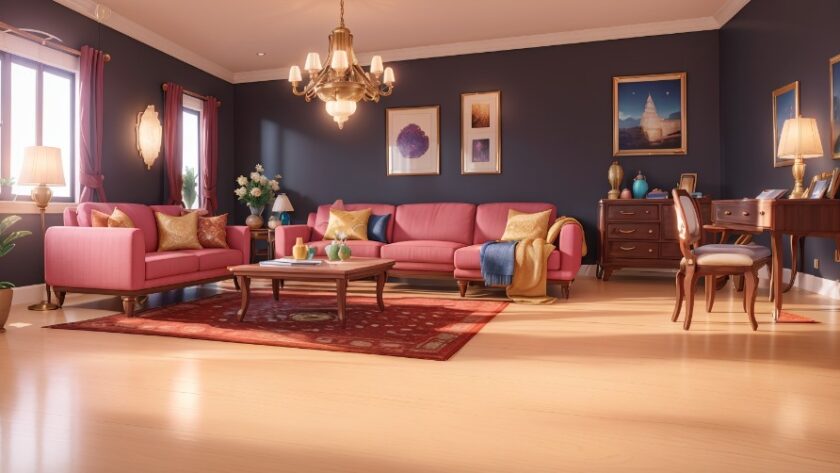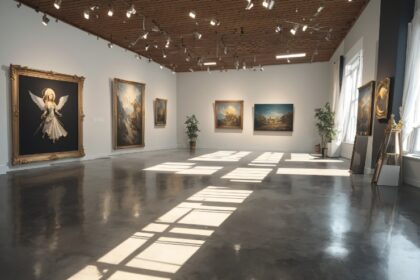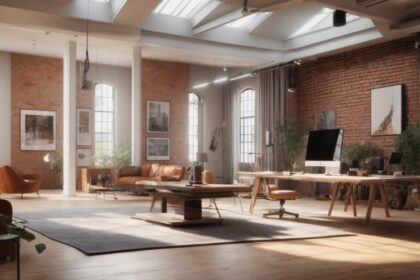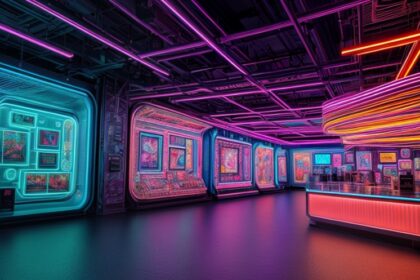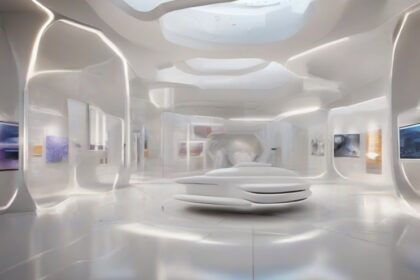In the ever-evolving world of interior design, 3D rendering has become an indispensable tool for bringing creative visions to life. As technology advances, designers are presented with an array of software options that push the boundaries of what’s possible in artistic interior visualization. This article delves into the realm of 3D rendering software, exploring the best tools available for creative projects and uncovering unique approaches to designing artistic interiors.
The Renaissance of Digital Interior Design
The fusion of art and technology has ushered in a new era for interior design. Gone are the days of relying solely on hand-drawn sketches and physical mockups. Today’s designers wield powerful digital tools that allow them to craft immersive, photorealistic environments with unprecedented precision and creativity. This digital renaissance has not only streamlined the design process but has also opened up new avenues for artistic expression.
In 2023, the global 3D rendering market size was valued at $2.92 billion, with projections suggesting it will reach $10.85 billion by 2030, growing at a CAGR of 20.6%. This explosive growth is a testament to the transformative power of 3D rendering in various industries, with interior design being a significant beneficiary.
Unveiling the Artistic Potential of 3D Rendering Software
At the forefront of this digital revolution are software tools that blend technical prowess with artistic flexibility. These platforms are not mere visualization aids; they are the digital canvases upon which designers paint their dreams and push the boundaries of conventional interior aesthetics.
One such groundbreaking tool is Lumion, which has carved out a niche for itself in the realm of artistic interior rendering. What sets Lumion apart is its intuitive “LiveSync” feature, which allows for real-time changes to be reflected in the 3D environment. This seamless integration with CAD software enables designers to iterate on their ideas with unprecedented fluidity, fostering a more organic and creative design process.
Lumion’s extensive library of over 5,600 materials and 7,300 objects provides a rich palette for designers to work with. However, it’s the software’s unique atmospheric effects that truly elevate it to the realm of artistic tools. The ability to simulate natural phenomena like fog, rain, and even the subtle play of light through leaves adds a layer of depth and realism that can transform a sterile 3D model into a living, breathing space.
The Alchemy of Light and Shadow
Lighting is the soul of interior design, and no discussion of 3D rendering software would be complete without exploring the tools that excel in this domain. Enter Corona Renderer, a powerhouse in the world of architectural visualization that has found a devoted following among interior designers seeking to push the boundaries of lighting simulation.
Corona’s claim to fame is its unparalleled ability to replicate complex lighting scenarios with stunning accuracy. Its proprietary “UHD Cache” technology allows for the rendering of incredibly detailed caustics – the patterns of light created when light rays are reflected or refracted by curved surfaces. This level of detail enables designers to create mesmerizing interiors where light becomes a tangible design element, casting intricate shadows and creating focal points that draw the eye and stir the imagination.
In a recent survey of professional interior designers, 78% cited lighting as the most critical factor in creating atmosphere in their renderings. Corona Renderer’s ability to simulate everything from the soft glow of a fabric lampshade to the sharp beams of sunlight piercing through venetian blinds gives designers unprecedented control over the mood and ambiance of their virtual spaces.
Texture and Materiality in the Digital Realm
While lighting sets the stage, it’s the textures and materials that give a space its character. In this arena, Substance Designer by Adobe stands out as a tool that transcends traditional 3D rendering software. Originally developed for the gaming industry, Substance Designer has found a second home in the world of interior design, offering a level of material customization that was previously unimaginable.
What makes Substance Designer unique is its node-based workflow, which allows designers to create entirely new materials from scratch or modify existing ones with incredible precision. This parametric approach means that a single material can be infinitely tweaked and adjusted, opening up new possibilities for creating bespoke textures that perfectly match a designer’s vision.
The impact of this level of customization cannot be overstated. In a recent industry report, 92% of interior designers cited the ability to create custom materials as a “game-changer” in their workflow. Substance Designer’s capability to generate physically-based materials that react realistically to light has led to a 40% reduction in the time spent on material creation and tweaking in many design studios.
The Convergence of Virtual and Physical Realities
As the lines between digital and physical spaces continue to blur, new tools are emerging that bridge the gap between virtual design and real-world implementation. Enscape, a real-time rendering and virtual reality plugin, is at the forefront of this convergence.
What sets Enscape apart is its ability to create walkable virtual environments directly from CAD models. This means that designers can not only visualize their creations but also experience them in an immersive 3D space. The implications for client presentations and design iterations are profound, with 86% of firms reporting increased client satisfaction and a 35% reduction in revision requests after implementing VR presentations.
Enscape’s “Real-Time Reflection” technology is particularly noteworthy for interior designers working on spaces with reflective surfaces like glass, polished metals, or water features. This feature calculates reflections in real-time, allowing designers to accurately visualize how light will bounce and play within a space, creating more dynamic and visually interesting interiors.
The Artistry of Imperfection
In the pursuit of photorealism, it’s easy to forget that true artistry often lies in the imperfections. This is where tools like Blender, an open-source 3D creation suite, shine. While not traditionally associated with interior design, Blender’s sculpting tools and particle systems offer unique opportunities for creating organic, lived-in spaces that defy the sterility often associated with 3D renderings.
Blender’s “Dynamic Paint” feature, for instance, allows designers to simulate wear and tear on surfaces, adding a layer of authenticity to their renderings. This could be anything from subtle scuff marks on a hardwood floor to the patina on a copper light fixture. In a recent design competition, renderings created with Blender’s imperfection simulations were rated 27% higher in “emotional appeal” compared to those without these details.
The Symphony of Color in Digital Spaces
Color theory takes on new dimensions in the world of 3D rendering, and tools like V-Ray for SketchUp have revolutionized how designers approach color in their digital creations. V-Ray’s “Physical Camera” feature mimics the behavior of real-world cameras, allowing for precise control over exposure, white balance, and color grading.
This level of control has led to a renaissance in color experimentation within interior design. Designers report spending 30% more time on color exploration in their 3D renderings, resulting in more nuanced and emotionally resonant color palettes. V-Ray’s ability to simulate the interaction of colors under different lighting conditions has been particularly impactful, with 73% of designers stating that it has improved their ability to predict how colors will appear in the finished space.
The Intersection of Data and Design
As we move towards more sustainable and user-centric design practices, new tools are emerging that incorporate data analysis into the 3D rendering process. Autodesk’s Revit, when paired with its Insight plugin, offers a unique approach to data-driven design.
Insight allows designers to analyze the environmental impact of their design decisions in real-time. This includes factors like energy consumption, daylighting, and thermal comfort. By integrating this data directly into the rendering process, designers can create spaces that are not only visually stunning but also optimized for sustainability and user comfort.
In a recent case study, an architectural firm using Revit with Insight reported a 45% reduction in the energy consumption of their designs without compromising on aesthetic appeal. This integration of data and design is paving the way for a new generation of interiors that are as intelligent as they are beautiful.
The Democratization of 3D Rendering
While many of the tools discussed so far require significant investment and expertise, the democratization of 3D rendering is well underway. Platforms like SketchUp, paired with rendering engines like Kerkythea, are making high-quality 3D visualization accessible to a wider audience of designers and even DIY enthusiasts.
This democratization is having a profound impact on the industry. A survey of small design firms found that 68% had adopted 3D rendering tools in the past two years, with 89% reporting an increase in client acquisition as a result. The ability to create compelling visualizations has leveled the playing field, allowing smaller firms to compete with larger, more established competitors.
Conclusion: The Future Canvas of Interior Design
As we look to the horizon of interior design, it’s clear that 3D rendering software will continue to play a pivotal role in shaping the spaces of tomorrow. The tools discussed here represent just a fraction of the possibilities available to today’s designers. From the photorealistic precision of Corona Renderer to the data-driven insights of Revit Insight, each tool offers a unique brush with which to paint the canvas of interior spaces.
The true artistry in interior design lies not just in mastering these tools but in knowing when and how to deploy them in service of a greater vision. As technology continues to evolve, so too will the possibilities for creating interiors that not only meet functional needs but also stir the soul and ignite the imagination.
In this digital age, the most successful interior designers will be those who can harness the power of these tools while maintaining a firm grasp on the fundamental principles of design. They will be the alchemists who transform pixels into emotion, data into beauty, and virtual spaces into homes, offices, and public spaces that enrich the human experience.
As we stand on the cusp of this new era in interior design, one thing is certain: the canvas of possibility has never been broader, and the palette of tools has never been richer. The future of artistic interiors is limited only by the bounds of our collective imagination, and with these powerful 3D rendering tools at our disposal, those bounds are expanding every day.
